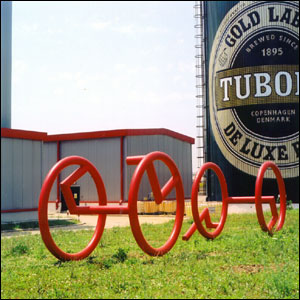Letter From Romania I: A Dialogue BetweenArt and Industry
In Romania, the notion of privately funded cultural initiatives is still in its very early stages. Until only recently, wealthy members of Romanian society have been reluctant to contribute to the arts, and artists across all mediums have traditionally found it difficult to secure any degree of financial backing from the upper class. Three years ago, however, a wealthy marble manufacturer from Baia Mare was approached by an ambitious artist proposing the formation of a private museum for Romanian contemporary art. Together they created the Florean Museum, named after the wealthy marble magnate who sponsored its development. The foundation of the Florean Museum is extraordinarily remarkable considering the fact that until only three months ago, not even the Romanian government had considered funding such an enterprise.
The Florean Museum features a wide array of works by famous Romanian artists who gather together each year at painting and sculpting camps held in Carbunari, a small village near Baia Mare, to practice their trade. These different camps last for one to two months, and the artists in attendance are paid for their time and their creations are added to the patrimony of the museum.
 A similar convergence of art and industry recently took place in Bucharest. Marius Leonte, a sculptor, approached Isaac Scheps, the president of Tuborg, a successful beer company, with an interesting proposal – to decorate the grounds surrounding the beer factory with monumental sculptures. Factories such as the Tuborg factory can be found throughout the Romanian countryside, disfiguring the landscape, and it was Leonteís idea to beautify this particular factory in such a way as to transform it into a unique landmark of art and industry. With Schepsí approval, a team of eight artists, seven sculptors (Christina Iliescu, Grigorie Minea, Gheorge Zarnescu, Costel Iacob, Horia Bojin, Ionel Cojocariu, Marius Leonte), and a painter (Vladimir Setran) gathered together to create a relationship between the industrial landscape of the factory and the outskirts of Bucharest. In order to do this, they decorated the factory grounds with tri-dimensional, vividly-colored works of art made from welded steel, limestone, ceramics, and glass. Gheorge Zarnescu, for instance, chose to work with a theme of chariots, and his large, red, wheels of steel and iron provide visual reference points for the whole composition. Vladimir Setranís monumental sculpture – a tri-dimensional image of his trade – focuses on the primary colors of red, yellow, and blue, as well as on the powerful effect of their juxtaposition.
A similar convergence of art and industry recently took place in Bucharest. Marius Leonte, a sculptor, approached Isaac Scheps, the president of Tuborg, a successful beer company, with an interesting proposal – to decorate the grounds surrounding the beer factory with monumental sculptures. Factories such as the Tuborg factory can be found throughout the Romanian countryside, disfiguring the landscape, and it was Leonteís idea to beautify this particular factory in such a way as to transform it into a unique landmark of art and industry. With Schepsí approval, a team of eight artists, seven sculptors (Christina Iliescu, Grigorie Minea, Gheorge Zarnescu, Costel Iacob, Horia Bojin, Ionel Cojocariu, Marius Leonte), and a painter (Vladimir Setran) gathered together to create a relationship between the industrial landscape of the factory and the outskirts of Bucharest. In order to do this, they decorated the factory grounds with tri-dimensional, vividly-colored works of art made from welded steel, limestone, ceramics, and glass. Gheorge Zarnescu, for instance, chose to work with a theme of chariots, and his large, red, wheels of steel and iron provide visual reference points for the whole composition. Vladimir Setranís monumental sculpture – a tri-dimensional image of his trade – focuses on the primary colors of red, yellow, and blue, as well as on the powerful effect of their juxtaposition.
The epic sculptures made and placed within the courtyard of the Tuborg beer factory enhance more than just the appearance of the factory grounds. The presence of these sculptures creates a more thoughtful and majestic atmosphere in the midst of one of many Romanian outskirts damaged by forced industrialization. There are, of course, countless other urban outskirts like that of Bucharest that have suffered from the introduction of massive industrialization, but now, at least, on the way from Bucharest to the seaside, travelers may wonder at the rare sight of an industrial courtyard teeming with lively, vividly-colored sculptures and glassworks.
In order to gain more appreciation from the general population for their work, Romanian artists such as Leonte need a source of considerable financial support. Though industry is well equipped to provide artists with this much-needed support, it might be some time before the two fully realize the true potential of their cooperation. For their own part, the sculptures within the courtyard of the Tuborg beer factory represent only the beginnings of what is possible when the power of industry is used to support artists in their efforts to improve the cultural richness of the society we live in.




